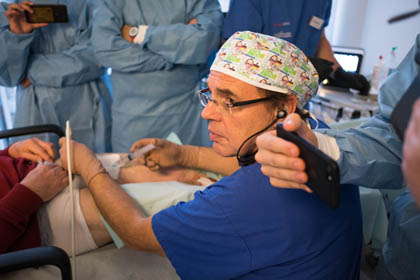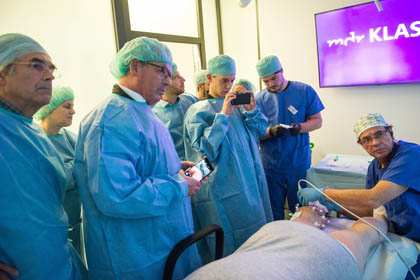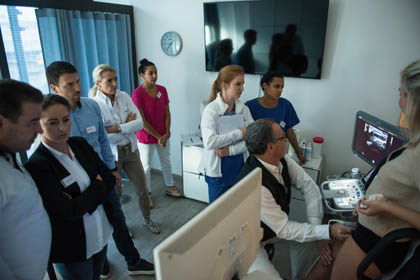VENARTIS Innovation Award 2017
Andreas Nilsson from Sweden is the winner of the ‘1st VENARTIS Phlebology Innovation Award 2017’. Nilsson was honored for his outstanding work, “Can innovative compression textile technology keep up with recent research?“ On February 6, 2018, the award was handed over by Chris Ragg (Chairman of Venartis® Board) und Sergio Gianesini (President of vWIN foundation) at UIP World Congress of Phlebology in Melbourne.
Can innovative compression textile technology keep up with recent research?
Author: Andreas Nilsson, Ph.D.
Jarnvagsplatsen 1, 524 30 Herrljunga Sweden This email address is being protected from spambots. You need JavaScript enabled to view it.
Background
The need for graded compression has recently been questioned since application of a higher pressure over the ankle area did not substantially increase the effect of the venous calf muscle pump 1,2. This understanding has facilitated the usage of a compression bandage designed to apply a uniform controlled pressure 2. However, a bandage is not the best solution for all patients. Compression treatment with stockings is a challenging task mainly due to custom fitting, poor patient compliance and the fact that leg size and leg shape often varies over time in the same patient due to varying levels of oedema. The aim was therefore to evaluate if a stocking with novel textile technology can apply a uniform pressure on the lower leg regardless of leg shape and size.
Methods
Ten healthy subjects (5 men and 5 women) mean age 44 years were included in the study. Contact pressure between skin and stocking were measured five locations on the lower leg. The sensors were placed unilaterally on the subject’s leg. The leg to be measured on the subject was selected randomly. Two sensors were placed approximately 12 cm from the medial malleolus (medial=B1, lateral = B2 ) and three sensors were placed at the maximum circumference of the calf (medial = C1, posterior = C2 and lateral = C3). A prototype compression stocking (PressCise AB, Sweden) with Lundatex patented textile technology was applied on the leg with pressure sensors. The stocking was used as a ’one size fits all’, meaning that all participants used the same size stocking. The stocking was designed to apply approximately 20-22 mmHg of pressure regardless of leg size and leg shape. Contact pressures were then recorded with a Picopress (Microlab, Italia) in supine position, supine position during maximum dorsiflexion of the foot and in standing neutral position.
Results
Leg circumferences were mean 25.8 cm, min 20.7 cm and max 29.3 cm at the position of the B1 sensor and mean 39.5 cm, min 30.3 cm and max 51 cm at the C1 position. The contact pressures were fairly consistent (Table 1).
Table 1. Contact pressures between the Lundatex stocking and skin measured on eight subjects in supine position, supine during maximum dorsiflexion of the foot and in standing position. Data presented as mean and standard deviation.

Discussion
Effective compression treatment with compression stockings is to a large degree a battle against varying leg shapes and leg sizes. The stocking evaluated in the present study applies an adequate contact pressure regardless of tested leg sizes. This indicates that efficient compression treatment may be consistent over time regardless of changes in leg shape and size due to leg fluid shift. The novel textile technology of the stocking applied a rather uniform pressure regardless of the fact that the legs circumference varied between 20.7 and 51 cm. This shows that a few standard sizes of the stocking may cover the whole range of leg sizes and that custom fitting will not be required. Another factor in the compression battle is patient compliance. One way to improve patient compliance may be to use more comfortable stockings without areas of unnecessary high compression.
Conclusion
The study showed that the novel stocking applies a rather uniform pressure regardless of leg circumference. The new textile compression technology used in the stocking may result in more consistent compression treatment and also cost savings due the fact that adequate compression may be obtained without custom fitting.
References
- Mosti, G., and H. Partsch. "Improvement of venous pumping function by double progressive compression stockings: higher pressure over the calf is more important than a graduated pressure profile." European Journal of Vascular and Endovascular Surgery 47.5 (2014): 545-549.
- Mosti, G., and H. Partsch. "High compression pressure over the calf is more effective than graduated compression in enhancing venous pump function." European Journal of Vascular and Endovascular Surgery 44.3 (2012): 332-336. 2. Wiklander et al. "An investigation of the ability to produce a defined ‘target pressure’ using the PressCise compression bandage." International wound journal (2015).
Conflict of interest
The author is CEO of PressCise AB, Sweden.
Editor´s comment:
The main reasons for selecting this contribution for the 2017 Venartis Phlebology Innovation Award were 1) the solid scientific basis, 2) the potential patient benefit by easier donning and more comfortable wearing for a majority of instances while achieving adequate pressures, 3) the product was ready for marketing.
During the UIP 2018 ‘New technology session’ in Melbourne, Andreas Nilsson gave a talk on his project and while he was presenting, he revealed he was wearing one of the novel stockings with a Picopress underneath, showing 22 mmHg. He removed the stocking from his leg and put it over his arm. Obviously, this should result in a big loss of pressure, according to compression modalities we are used to. However, Picopress showed a pressure of 17 mmHg! We have to accept this as proof of alternative textile compression methods, which are more independent from leg circumference and exact leg measurements. The clinical benefits and indications for this device (most probably not those requiring methods with a high stiffness index) still need to be established.



